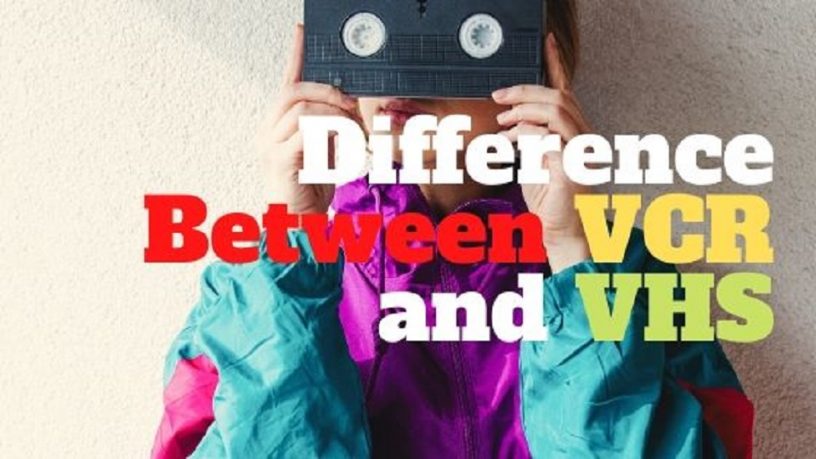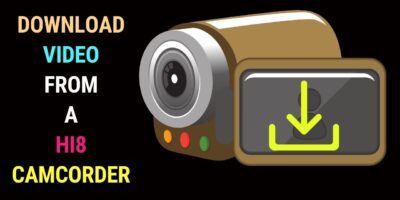Last updated on January 23rd, 2024 at 02:33 am
Updated 24.6.2021
Summary
VCR stands for Video Cassette Recorder and VHS stands for Video Home System. VCR is a machine (video player) and VHS is a videotape. Video can be recorded on a VHS tape via a video camera or from television. There are also pre-recorded movies available on VHS
VCR and VHS work together. However, there’s a difference between them as you’ll see in the following sections of this VHS wiki.
VHS Acronym
VHS stands for Video Home System.
Are VCR and VHS the Same?
No, VCR and VHS aren’t the same. VCR is a video player and VHS is a video cassette/tape.
VHS is an analog tape format with a tape width of half an inch. VHS tapes were first available in the USA in 1977, having been released a year earlier in Japan.
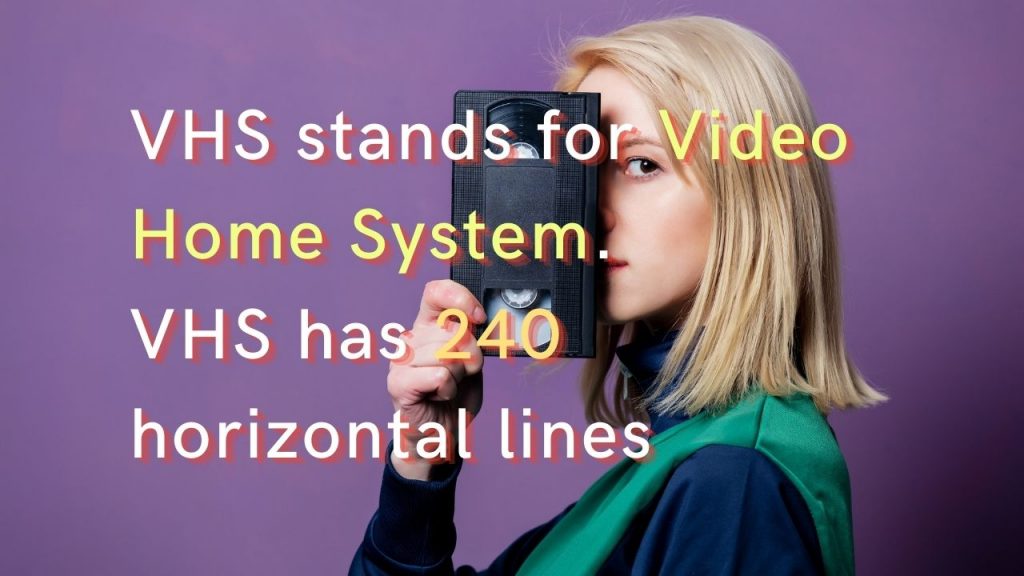
VHS Resolution
It’s a low-quality video format that promises about 240 horizontal lines. That is the resolution you get for a VHS tape recorded in SP (Standard Play) mode.
When recorded at lower speeds (LP), you get a longer recording time. However, the quality will be much lower.
Check out the different VHS recording modes for PAL and NTSC.
VHS Aspect Ratio
In its native format, VHS has an aspect ratio of 4:3. However, a video with the 16:9 aspect ratio can be copied to a VHS tape employing the letterboxing method.
The widescreen or anamorphic VHS method can also be used to fit a 16:9 video into a VHS tape. However, this will require TV supports 16:9 or one that can switch between 4:3 and 16:9.
If anamorphic VHS is played on a 4:3 TV, then the images will appear unusually tall or thin.
What Does VCR Stand For?
VCR stands for Video Cassette Recorder.
VCR is a machine (video player) and VHS is a videotape.
Video can be recorded into a VHS tape via a video camera or from television. There are also pre-recorded movies available on VHS.
In the early days, VCRs were called time-shift machines.
What does that mean? It means you could record a TV show and watch it at a later time.
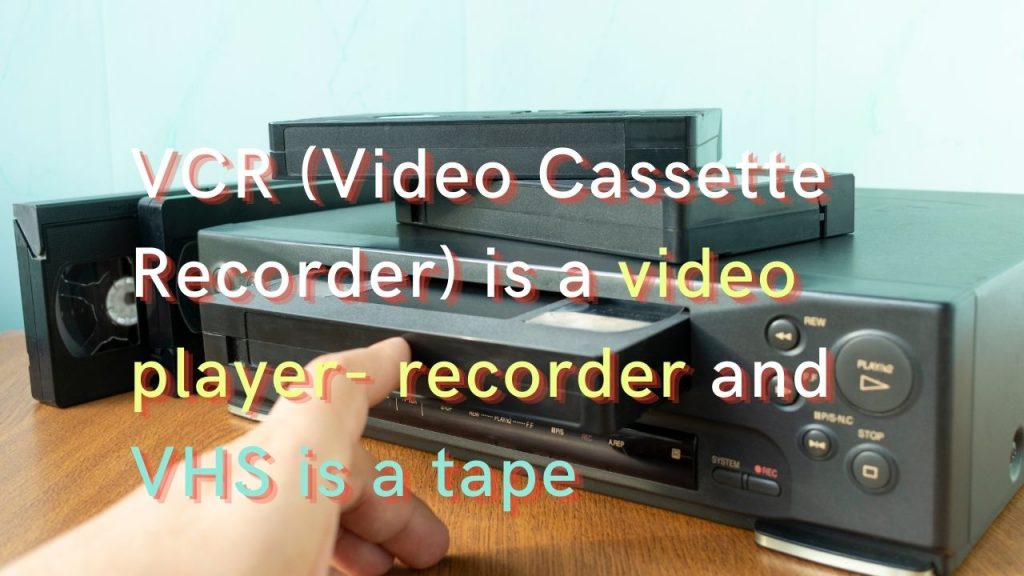
How Do You Play a VHS Tape?
To playback a VHS tape, you would need a VHS player or a VCR. A video player can only play back video from a VHS tape.
A VCR can also play a VHS tape. It can also record on a blank VHS tape from a television set or from another video player playing a VHS tape.
So, a VCR is a video player- recorder. VHS is a tape.
You put a VHS tape into a VCR to watch the video it contains.
That said, the term VCR doesn’t only apply to the playing and recording of video on VHS tapes.
It also applies to other video cassette formats like 8mm and mini-DV.
Thus we have 8mm VCRs playing and recording different 8mm video formats. We have Video8, Hi-8 and Digital8 VCRs. We also have mini-DV VCRs.
These VCRs play back only the tape format they’re designed to support.
On the other hand, a VHS VCR can not only play back VHS tapes but also VHS-C (VHS-Compact) tapes. This is done with the help of a VHS-C to VHS adapter.
But generally, when we talk about VCRs, we often refer to VHS VCRs as they’re more commonly available in the market.
Other VHS Tape Types
The following are the variants of the VHS tape, some ranging in quality and size.
VHS-C
The standard VHS tape has a smaller version or compact version called VHS-C or VHS-Compact. The only difference is the size. Other than that, the video quality is the same.
VHS-C camcorders were once popularly in place of the bulky VHS camcorders.
Its main advantage is you don’t need a special VHS-C VCR to play it back. It can be played back through a VHS VCR by inserting the tape into a VHS-C adapter as explained above.
S-VHS
S-VHS stands for Super-VHS. As the name denotes, it offers a superior picture quality compared to standard VHS.
While VHS offers a horizontal resolution of 240 lines, S-VHS offers a horizontal resolution of 400 lines.
Read more about the difference between VHS and S-VHS.
D-VHS
D-VHS stands for Digital VHS. It was introduced in 1998.

D-VHS was the only video format that offered high-definition video before the advent of HD-DVD and Blu-ray.
Jointly developed by JVC, Hitachi, Matsushita (Panasonic), and Philips, D-VHS was supposed to rival DVD which offered only standard-definition video.
D-VHS Resolution
D-VHS can record at a resolution of 1080i or 720p.
The video bitrate of D-VHS is 14Mbit/s as opposed to DVD’s 5 Mbit/s.
But then D-VHS started off as a standard-definition video format. High-definition video was offered later.
Recording time on a D-VHS tape is reduced by half when high-definition video is recorded on it.
So a 240-minute D-VHS tape will only manage 120 minutes of HD video.

You can’t play a D-VHS tape over a standard VHS or S-VHS player. However, you can play a standard VHS and S-VHS tape on a D-VHS VCR.
D-VHS VCR
You can record video in MPEG-2 at 1080i or 720p HD quality with a D-VHS VCR.
There are 3 D-VHS recording modes – High Speed, Standard (STD) or Low Speed (LS).
Low Speed is further divided into 3-Speed (LS3) and 5-Speed (LS5).
The various recording modes may seem to be D-VHS’ strong point. However, it only served to confuse consumers.
Watch the video for a quick demonstration of what the quality D-VHS is like. You’ll be amazed, especially with the chapter search function.
D-VHS’ ‘Demise’
Not only were the different recording modes confusing to consumers, but there were also other issues as well.
To start off, there were D-VHS playback issues. If you recorded a D-VHS tape on a Panasonic VCR you can’t play it on a JVC D-VHS VCR. The reverse is also true.
Also, there was only one way to record HD video with a D-VHS VCR. It was through Firewire.
Only a few TV sets came with Firewire connections. There were also a limited number of Firewire-enabled cable boxes.
The death knell was sounded for D-VHS in 2006 with the entry of Blu-ray and HD-DVD.
That said, D-VHS-related products are still available for purchase online should you wish to explore this short-lived video format.
Check out the JVC DF300AU D-VHS Video Tape.
VHS-HQ
VHS HQ stands for VHS High Quality. This tape format promises a slightly-better quality picture compared to a standard VHS tape.
A standard VHS tape supports 240 lines of horizontal resolution. VHS HQ supports 250 lines of horizontal resolution.
You can play a VHS HQ tape on a non-HQ VHS VCR.
Standard VHS Tape Recording Modes
You can record on a VHS tape in 3 modes – Standard Play (SP) Mode, Long Play (LP), and Extended Play (EP), also known as Super Long Play (SLP) and Slow Play.
Standard Play promises the highest quality and Extended Play the lowest quality.
How Long Can VHS Tapes Record?
VHS tapes can record for a minimum of 20 minutes and a maximum of 180 minutes in SP Mode.
In LP Mode it can record a minimum of 40 minutes to a maximum of 360 minutes.
In EP mode, VHS tapes can record a minimum of 60 minutes to a maximum of 540 minutes.
Refer to the table below for the recording times available in the three different modes.
| VHS Tape Type | SP Mode (Minutes) | LP Mode (Minutes | EP Mode (Minutes) |
| T-20 | 20 | 40 | 60 |
| T-30 | 30 | 60 | 90 |
| T-45 | 45 | 90 | 135 |
| T-60 | 60 | 120 | 180 |
| T-90 | 90 | 180 | 270 |
| T-120 | 120 | 240 | 360 |
| T-160 | 160 | 320 | 480 |
| T-180 | 180 | 360 | 540 |
Originally Only SP Mode for VHS Standard
The official VHS standard set by JVC didn’t include LP speed. It was created out of necessity to maintain VHS’ competitiveness in the home video market. It was mainly done with the intention of keeping VHS’ main competitor, Betamax at bay.
JVC’s first VHS VCR, HR-3300 supported a 120-minute SP speed. The whole idea was to beat Beta I’s 60-minute tape playback limit.
Then Sony released Beta II which doubled the recording time for Beta VCRs.
Other VHS VCR/tape manufacturers (not including JVC) countered with LP speed recording.
Eventually, JVC introduced the EP (Extended Play) speed in 1979.
Why is a Blank VHS Tape Marked T Followed by a Number?
The T indicates that the tape is of the NTSC type. The number denotes the play time available in minutes.
So, if a tape is marked T12O, it means it is an NTSC tape with a record and play time of 120 minutes in SP mode.

If a tape is marked E180, E means the tape is of the PAL type with 180 minutes of playtime.
How is a VHS HQ Tape Different from a Standard VHS Tape?
VHS Resolution
A VHS HQ tape offers a horizontal resolution of 250 lines. A standard VHS tape offers a resolution of 240 lines.
VHS Players for Sale
VHS players are no longer manufactured. However, you can still lay your hands on a reliable refurbished unit. You may need one to play back your VHS tapes if they’re still in good condition.
Most importantly, you’ll need a VHS player as a playback device to convert your VHS tapes to digital.
Though they are refurbished units, they’re reliable for the most part, having been serviced by experienced technicians.
Toshiba W-528 VCR Video Cassette Recorder 4-Head Hi-Fi Stereo VHS Player
This VHS video cassette recorder allows you to play VHS tapes and record on them.
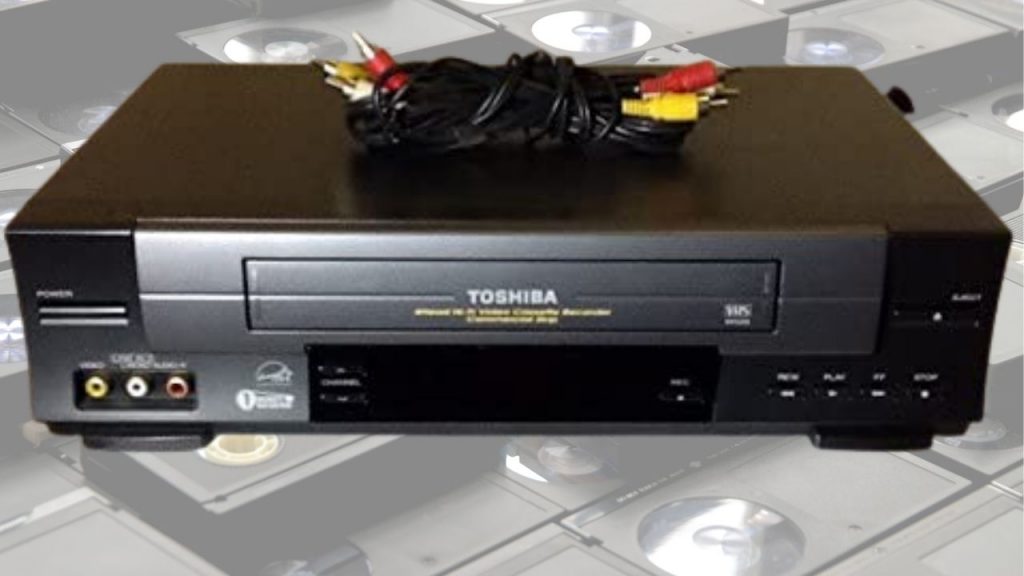
This is a 4-Head Hi-Fi Stereo Omnivision VHS player.
Check out this Toshiba W-528 VCR.
Sony SLV-N55 4-Head Hi-Fi VCR
This is a Sony 4-head HiFi VCR that can rewind a full T-120 tape in about 60 seconds.
It boasts an auto head cleaner and comes with automatic digital tracking. Its 19-micron video heads provide superior picture quality even for a tape playing in EP mode.
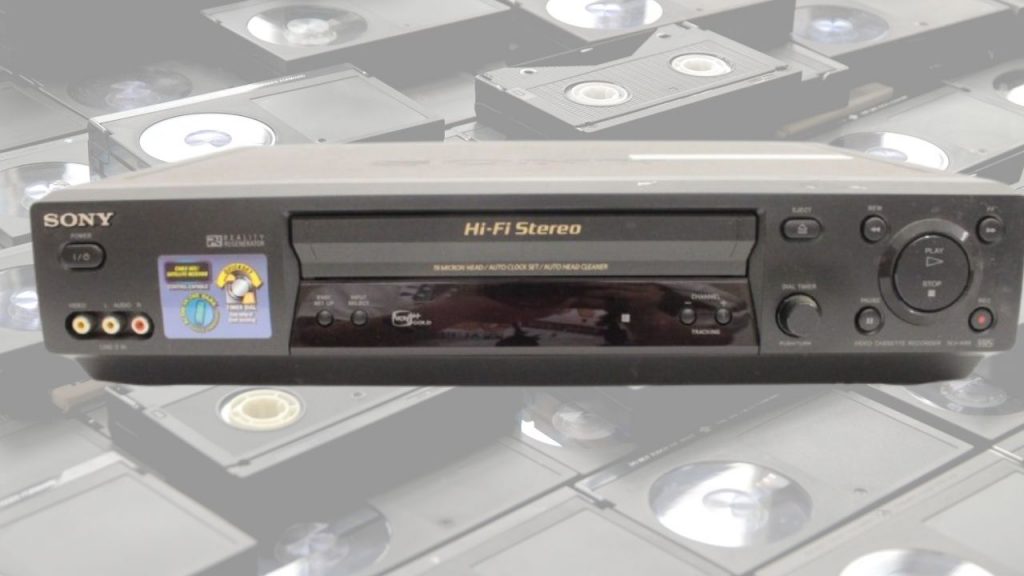
What’s more, you get to enjoy Hi-Fi stereo sound. It measures 3-3/4Hx14-1/4Wx9-2/5D”.
Check out the Sony SLV-N55 4-Head Hi-Fi VCR.
Other VHS Player Options
TV VCR Combos
Apart from standalone VHS players, there are also VHS players attached to a TV. They’re known as TV VCR combos. These TVs with VHS players were popular back in the day and saved the hassle of connecting a VCR to a TV.
Portable VHS Players
Back in the day, there were mini VHS players that could be carried around easily. These portable VHS players are still offered for sale online.
VHS Accessories
Although the VHS revolution is as good as over, there are still VHS-related accessories available for sale online.
If you are in the mood to take a trip down memory lane, here are some VHS-related accessories you may want to consider.
VHS Blank Tapes
You may need a VHS blank tape to make a backup of another VHS tape or simply to transfer footage from a camcorder to play back on your television.
Take a look at the following reliable VHS blank tapes available for sale online.
3-Pack Craig CC358 Premium Blank T-120 VHS Video Tapes
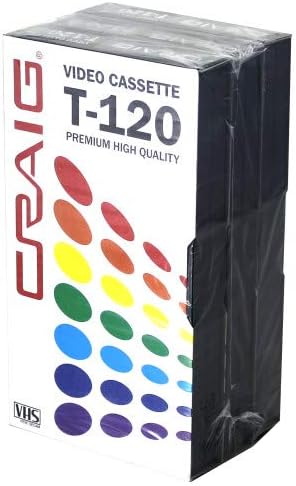
This VHS tape offers high-quality picture and sound recording, much better than you would get with a regular VHS tape.
Check out this 2-hour VHS blank tape pack.
Learn more about the different types of blank VHS tapes for sale.
VHS Tape Adapters
One of the most sought-after VHS products is the VHS tape adapter. Such a tape adapter allows a tape of a non-VHS size to fit into it and be played on a VHS machine.
VHS Tape Adapter for VHS-C Tapes
You can play a VHS -C tape with a VHS VCR by using the VHS-C tape adapter.
VHS Tape Adapter for mini-DV Tapes
Those who don’t have access to a mini-DV camcorder often look for a VHS tape adapter for mini-DV tapes.
VHS Tape Adapter for 8mm Tapes
Many looking to convert 8mm tapes to digital wonder if they could do it, through their VCR,
Just like there’s no VHS adapter for MiniDV tapes, there isn’t an adapter to play 8mm tapes through a VHS VCR.
How to Play VHS Tapes on a Smart TV
The age of analog TV is over. You can no longer buy a new analog TV. If your old analog TV is no longer functional, you may have bought a smart TV, especially to enjoy video streaming services like Netflix and Amazon Prime.
You may now wonder if you can connect your VCR to your smart TV.
Even if your TV doesn’t come with analog video input, you can still connect your VCR to your smart TV.
VHS Fun Facts
- Sony successfully introduced the 1/2-inch Betamax VCR to the consumer market in 1975. It was the first successful VCR to hit the home market.
- JVC (Victor Company of Japan) developed the VHS or Video Home System.
- JVC followed up with the VHS VCR in 1976 which was to displace Betamax as the preferred consumer videotape format.
- VHS was released in Japan on September 9, 1976.
- It was introduced to the USA market about a year later on 23rd August 1977.
- VHS did not only face competition from Betamax. It was also challenged by the Video 2000 tape format which offered double the VHS tape playback time.
Read More
S-VHS vs VHS: What is the Difference Between VHS and S-VHS?
VHS and Blu-ray Combo Player: Play VHS, Blu-ray, DVD, VCD, and Digital Video Files on a Single Unit
What is Macrovision Protection in VHS and DVD?
VHS vs Betamax: Why VHS Beat Betamax?
What’s the Best Way to Convert VHS-C to Digital? You Have Three Options
Best VHS to DVD Converters: Choose the Top Software, Capture Devices, and DVD Recorders
Free VHS to Digital Converter Software Programs
References
Getting the Most Out of Your Video Gear By Gerald V Quinn
The Big Showdown: Are those LP and EP Movies Really a Bargain? in Video Review Magazine July 1988
D-VHS section of FCC Record: A Comprehensive Compilation of Decisions …, Volume 19, Issue 19 page 15895
A Fix for Satellite TV Recording: Popular Science September 1997
